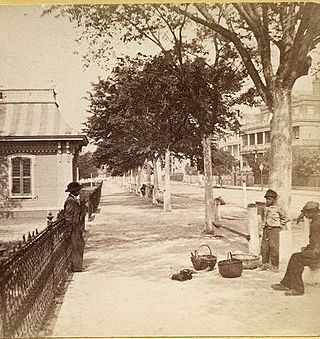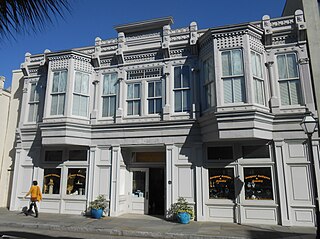
White Point Garden is a 5.7 acre public park located in peninsular Charleston, South Carolina, at the tip of the peninsula. It is the southern terminus for the Battery, a defensive seawall and promenade. It is bounded by East Battery, Murray Blvd., King St., and South Battery.

Johnson Hagood Stadium, is an 11,500-seat football stadium, the home field of The Citadel Bulldogs football team, in Charleston, South Carolina, United States. The stadium is named in honor of Brigadier General Johnson Hagood, CSA, class of 1847, who commanded Confederate forces in Charleston during the Civil War and later served as Comptroller and Governor of South Carolina.
Rainbow Row is the name for a series of thirteen colorful historic houses in Charleston, South Carolina. The houses are located north of Tradd St. and south of Elliott St. on East Bay Street, that is, 79 to 107 East Bay Street. The name Rainbow Row was coined after the pastel colors they were painted as they were restored in the 1930s and 1940s. It is a popular tourist attraction and is one of the most photographed parts of Charleston.

The Old Exchange & Provost Dungeon, also known as the Custom House, and The Exchange, is a historic building at East Bay and Broad Streets in Charleston, South Carolina. Built in 1767–1771, it has served a variety of civic institutional functions, including notably as a prisoner of war facility operated by British forces during the American Revolutionary War. The building was designated a National Historic Landmark in 1973. It is now a museum operated by the Daughters of the American Revolution.

Pink House is a historic house and art gallery at 17 Chalmers Street in Charleston, South Carolina that is one of the oldest buildings in South Carolina and is the second oldest residence in Charleston after the Colonel William Rhett House.
Colonial Lake is a tidal pond in Charleston, South Carolina with wide walkways around it. The area is used as a park. For many years the lake was known as the Rutledge Street Pond; some residents still call it "The Pond." It acquired the name Colonial Lake in 1881, in honor of the "Colonial Commons" established in 1768.

The Benjamin Simons Neufville is a Greek Rival house at 72 Anson St., Charleston, South Carolina. It is one of the largest houses in the Ansonborough neighborhood. The house was built by Eliza Neufville Kohne in 1846 and remained in the family until 1904. The house was purchased by the Historic Charleston Foundation in 1959, which added a brick and wrought iron fence and tore down a later addition to the home, before selling it in 1962. While much of the interior was original, a fire in the 1950s resulted in much of the first floor of the home requiring extensive repairs.

The People's Building at 18 Broad St. was Charleston, South Carolina's first "skyscraper", erected in 1910 and 1911 at a cost of $300,000. It was designed by a Swedish architect, Victor Frohling of Thompson & Frohling, of New York and built by both Simons-Mayrant of Charleston and also the Hadden Construction Co. Construction began on December 7, 1909. The pile driving so weakened a nearby residence that the People's Building & Investment Co. had to buy it. The structure is a steel framed building with iron framing whose engineer was D.C. Barbot. Work continued throughout early 1910. The construction of the building became a popular spectacle for residents to watch. An American flag was placed atop the building's frame when it was topped out in late April 1910. The owners of the building considered installing a rooftop garden to take advantage of the superb views from the building.

The Joseph Floyd Manor is a public housing facility designated for elderly and disabled citizens. It is in the upper peninsula area of Charleston, South Carolina. The building is located at 2106 Mt. Pleasant Street, on the northwest corner of Mt. Pleasant St. and King St. The 12-story building was originally known as the Darlington Apartments and was designed by William G. Lyles, Bissett, Carlisle & Wolff of Columbia, South Carolina. The facility has 156 single occupancy rooms.

The James Simmons House is a late 18th-century house at 37 Meeting Street, Charleston, South Carolina which was, at one time, the most expensive house sold in Charleston. It was likely built for James Simmons, a lawyer. By 1782, it was home to Robert Gibbes, a planter. Louisa Cheves, a prominent antebellum writer, was born at the house on December 3, 1810. In 1840, Otis Mills, the owner of the Mills House Hotel, bought the house for $9,000. In October 1862, during the Civil War, the house was loaned to Gen. Pierre Beauregard, who used the house as his headquarters until August 1863. In 1876, Michael P. O'Connor, later a member of Congress, bought the house.

The Williams Mansion is a Victorian house at 16 Meeting St., Charleston, South Carolina. The mansion is open for public tours.

The James Ferguson House at 442 King St., Charleston, South Carolina, is an antebellum house dating to at least 1840. As of 2000 it was being used as a restaurant.

The Carolina Rifles Armory at 158-160 King St., Charleston, South Carolina, was a late 19th-century headquarters for a semi-private military group, but today only the façade remains, facing an annex for the Charleston Library Society.

The Hannah Enston Building is a post-bellum commercial building at 171-173 King St., Charleston, South Carolina. A former building, constructed for furniture dealer William Enston, was burned in a fire in 1861. The replacement building was in place by 1872 when it was included in a bird's eye view map of Charleston. The building was built in the Gothic Revival style with similar decorative elements to 187-189-191 King St., a building built for William Enston sometime after 1848. After the death of William Enston, his property eventually was received by the trustees of a charity which he created to build the William Enston Home, and the trustees sold 171-173 King St. in 1888. From 1888 to 1909, the two halves of the building were separately owned. The southern portion of the building at 171 King St. was operated as a grocery by George Mazo; his son, writer Earl Mazo, and the rest of the family lived on the second floor.

Vanderhorst Row in Charleston, South Carolina is a three-unit residential building built in 1800 by Arnoldus Vanderhorst, a governor of South Carolina (1792-1794). Each unit is four floors. The units at the north and south end of the range have doors along East Bay Street on the front in addition to doors on the sides of the unified building and exits to the rear. After the Civil War, the use of the building changed, and commercial purposes were installed. The building fell into disrepair before it was bought in 1935 by Josiah E. Smith for a restoration which cost $30,000. The architect for the restoration of the building was Stephen Thomas. The three units rented for $1500 to $1800 a year after the work was completed. As restored, each unit had a living room, dining room, kitchen, breakfast room, and pantry on the first floor; a drawing room, bedroom, and bath on the second; two more bedrooms on the third; and servants' rooms in the attic. For many years after the restoration of the building, the central unit was rented by the Charleston Club for its headquarters; the club relocated to 53 East Bay Street in 1958.

The Elias Vanderhorst House at 28 Chapel Street, Charleston, South Carolina, is a four-story mansion house which was built around 1835 as a home for members of the prominent Vanderhorst family of plantation owners.

The Dr. William Snowden House was used as a hospital operated by its owner, Dr. William Snowden, and Dr. S nowden's wife, Amarynthia Yates Snowden. When bombardment of the city forced the Snowdens to evacuate to Columbia, South Carolina, the family's silver was buried in the yard; it was not unearthed until the 1920s when a box of the silver was found during landscaping work. After the Civil War, meetings were held in the house that led to the formation of the Confederate Home and College. The house was itself mortgaged to fund the creation of the institution, which existed to care for wives and daughters of Confederate soldiers.

Cabbage Row is a set of pre-Revolutionary buildings at 89 and 91 Church Street in Charleston, South Carolina. The buildings are most notable for having been the inspiration for "Catfish Row" in the DuBose Heyward novel Porgy and later the opera Porgy and Bess by Gershwin. DuBose Heyward had lived nearby on Church Street.

The Dr. Henry Frost Office at 98 Broad Street is composed of a front portion that appears to date from the mid-19th century and a rear portion that appears to be much older. The land upon which 98 Broad Street was built was owned by famous loyalist and horticulturalist Alexander Garden when he was forced to abandon the property when Charleston fell to the colonial forces in 1782.

Wagener Terrace in Charleston, South Carolina is a large neighborhood made property that had been owned by Louis Dunnemann and Capt. F.W. Wagener.




















